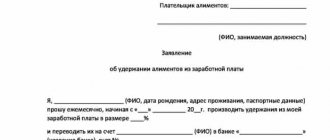Parents have equal obligations towards their children, regardless of their number or personal relationship. If the alimony payer has several children, it is necessary to correctly distribute the amount of payments between them, which will ensure the rights of both each of the recipients and the payer. Any interested party who believes that the existing procedure does not ensure the rights and freedoms of all parties to alimony obligations can initiate the division of alimony.
Dear readers! The article talks about typical ways to resolve legal issues, but each case is individual. If you want to find out how to solve your particular problem , contact a consultant:
+7 (499) 110-56-12 (Moscow)
+7 (812) 317-50-97 (Saint Petersburg)
8 (800) 222-69-48 (Regions)
APPLICATIONS AND CALLS ARE ACCEPTED 24/7 and 7 days a week.
It's fast and FREE !
Basic Concepts
Alimony is payments that persons specified in the Family Code must pay to certain categories of citizens (children, disabled parents, and so on). Recipients of alimony are to some extent financially dependent on payers (due to family ties and other circumstances).
The alimony payer is a person obliged to provide for the recipient within the limits established by an agreement or judicial act, and the recipient is a person who accepts such security from the payer.
An alimony agreement is a document voluntarily concluded between the payer and the recipient, on the basis of which alimony payments are calculated.
Division of child support is the process of distributing child support payments among all recipients.
The division is necessary for a more equitable distribution of funds, taking into account many factors, including the family and financial status of the parties.
Purpose of payments
The essence of alimony payments is to provide the recipient with a means of subsistence, the amount of which will be sufficient to meet his basic needs.
The size of payments will directly depend on the size of the payer’s income if he has official earnings. Otherwise, alimony can be paid in a fixed amount, which is specified in an agreement or court decision.
During a divorce, the parties divide jointly acquired property. By default it is distributed in equal shares, but by agreement any order can be determined. A different division procedure may be stipulated in the marriage contract, if one has been concluded. Also, after the divorce is completed, the issue of living for the children and providing them with alimony is decided.
If there are several children, they can be “divided” between spouses, that is, someone will remain with their mother, and someone with their father. In this case, alimony will be paid to the person whose financial situation is worse, or in accordance with the agreement of the parties.
The division of alimony payments is necessary to establish the most equitable distribution of the amounts paid by the payer for the maintenance of his children. Such a section should ensure both the rights of the payer and the recipients (taking into account their financial situation and other factors).
Is it possible to get alimony without getting a divorce? The answer is presented in the article “How to file an application for alimony while married.” You can find out how to stop alimony payments here.
Other options
It is not necessary to file a claim and collect alimony at the same time - these issues can be resolved separately. According to the law, it is possible to request payments for the maintenance of minors without divorce.
Submitting applications separately
The law allows for the collection of alimony during marriage. A woman can request payments for her child and herself if she is pregnant or on maternity leave. Alimony is assigned to the spouse in a fixed amount.
The Lavrentievs' marriage was registered in 2013. Since 2020, the couple have not lived together, the woman is on maternity leave, and there is a second five-year-old child. The divorce has not been officially filed.
To recover alimony for herself and her two children, the woman filed a lawsuit. Payments are assigned in a fixed amount, since the person obligated for alimony is not officially employed. He pays 10,000 rubles for children, 4,000 rubles for his wife.
When determining the amount of payments, the minimum amount for living was taken into account.
Collecting alimony after divorce
It is possible to separate the issues into two different trials. First, a claim for divorce is filed, then for alimony. The reverse sequence is also allowed, but it does not play a role when the court makes a decision on the case.
The Ignatiev couple got married in 2014 and had a son together. In 2017, they decided to divorce; the wife filed an application with the court in May. She agreed orally on the payment of alimony; the man said that he would transfer the money every month.
Divorce certificates received in July. Until June 2020, the woman did not see alimony, she made attempts to resolve the issue peacefully, but the ex-husband did not want to negotiate.
In June 2020, a claim was filed in court for the recovery of alimony in shares of a salary of 50,000 rubles.
50,000 x 25% = 12,500 rub. - amount of alimony.
The claims were satisfied.
Voluntary agreement
According to the RF IC, the parties can enter into agreements on the payment of alimony and on determining the residential address of minors without going to court. Notarization will be required.
The amount, period and procedure for transferring money are determined by the spouses or former spouses independently. Without the seal and signature of a notary, the document is considered invalid.
If the alimony payer does not comply with the terms of the agreement, the recipient has the right to present it to the bailiffs or to the accounting department at the place of his employment. The document is equal in legal significance to a writ of execution.
The spouses signed an alimony agreement in April 2020. In May, the woman filed a lawsuit for divorce. She had one child left with her - an 8-year-old daughter. Both parties agree to the divorce.
The divorce proceedings lasted a month from the moment the claim was received, the decision was made in one meeting. The parties had no disagreements, and the court had no grounds for setting a conciliation period.
The decision was received in early July, and the divorce certificates were received in August, since they are prepared within 30 calendar days at the registry office.
Who has the right
Any person indicated in the Family Code as a potential recipient of alimony (children, disabled spouses, parents, etc.) has the right to collect alimony.
In the case of child support payments, the parents with whom the children live can apply for their collection (in accordance with an agreement or a court decision).
In some cases, child support can be recovered from both parents if they both evade paying it. In this case, the collector will be the Guardianship and Trusteeship Authority.
Any interested person, both the payer and one of the recipients, who considers the current division procedure unfair, can apply for the division of alimony.
What are the difficulties?
The difficulty is this: there is no clear guidance in the law on which to make a decision. When making a decision, the court relies on internal beliefs
Therefore, it is important to provide compelling arguments: why it is necessary to transfer part of the alimony to the child’s account. The defendant is presumed innocent until proven guilty
You should estimate the amount of alimony to be transferred. If their size does not exceed the subsistence level, the chance of satisfying the request is minimal. Very often, the payer who transfers 3-5 thousand for a child is sure that for this amount not only the child, but also his mother eats black caviar. However, in reality, with this money it is impossible to even properly dress a child, not to mention decent maintenance. The payer, seeing the child in the same clothes, declares to the court that the mother is not spending the money on the child. And he will be completely wrong.
In addition, years of accumulated grievances do not allow an adequate response to information coming from the ex-spouse. In addition to desire, they seek confirmation of their fears. Having seen new boots on his ex-wife, the payer will be sure that they were purchased at the expense of his alimony.
The difficulty is that the reason for the claim is the misuse of funds by the parent, which is very difficult to prove.
Where to contact
An application for division of alimony payments must be submitted to the court. This category of cases is dealt with only by the magistrate’s court, regardless of the amount of alimony and other circumstances.
The application must be made in writing. It indicates all the circumstances relevant to the case, including the rationale for the division of alimony payments (for example, the presence of another recipient for this payer).
Any interested party can submit an application. This can be either a representative of the recipient of alimony (the parent with whom the child lives) or the payer himself, if he believes that the current procedure for dividing alimony payments infringes on his rights or the rights of the recipient.
Is alimony charged on premiums? The answer is presented in the article “How alimony is withheld from bonuses.” You can find out how to collect alimony from an individual entrepreneur (IP) here.
Requirements
The plaintiff has the right to demand divorce, divide property and recover alimony from the defendant. In this he will be guided by the following articles of the Family Code:
- Article 21: Describes the features of divorce through the court.
- Article 22: Describes the dissolution of a marriage without the consent of the other party.
- Article 24: Describes the features of divorce and related issues.
- Article 38: Dedicated to the division of property.
- Article 39: Talks about the shares assigned to each spouse upon division.
- Article 81: Establishes the amount of alimony.
It is not necessary to indicate specific points of these articles or describe in detail what exactly the applicant requires. It is enough to simply list all the articles that guide the plaintiff.
How is child support divided?
The distribution of alimony is carried out in court. Regardless of the circumstances, the issue cannot be resolved through administrative or other methods.
Even in the case of collection of alimony payments from both parents at once, the issue of collection is carried out only through judicial proceedings.
If the payer has other children (or other persons to whom he must pay alimony), the amount of payments collected from the payer’s income must be distributed among everyone.
To do this, you will need to prepare a package of documents and submit a corresponding application to the magistrate.
Next, the judicial act, after it comes into force, must be presented to the bailiff service in order to change the procedure for collecting alimony payments. Both the debtor and another interested person (one of the recipients of alimony) can submit a decision.
Cost of divorce
Despite the fact that the divorce is carried out in a government agency, you will need to pay a state fee for providing this service and registering new data. Its size is set depending on the authority where you apply: to the court or to the registry office.
At the registry office, this procedure will cost you 650 rubles for each spouse or 350 rubles if the application is submitted unilaterally. This is only possible if appropriate conditions exist. But through a judicial authority, the divorce service will cost 600 rubles per plaintiff. This rule is governed by Sections 333.26 and 333.19 of the Internal Revenue Code. The state fee must be paid before your application is considered both at the registry office and in court. You can find out how to do this quickly and correctly determine the cost of a divorce in our articles.
Package of documents
The following documents must be attached to the application for division of alimony payments:
- Document confirming the identity of the applicant.
- Papers on the basis of which alimony is collected at the time of filing the application.
- Documents about the financial situation of the payer.
- Documents on the birth of children (or other documents confirming the presence of other recipients of alimony).
- Other documents substantiating the applicant’s position.
Application structure
The application must contain the following information:
- Details of the court to which the application is being submitted.
- Details of the parties to the trial (plaintiff, defendant and third parties, if any).
- Information about children in whose favor alimony is calculated.
- Information about the financial status of the parties.
- Evidence of the need to divide alimony.
- Data on the required ratio of the division of alimony.
- Link to legislative acts.
- Attachments to the statement of claim.
- Date and signature of the applicant or his representative.
The application may also contain other information relevant to the case.
Duration of the proceedings and results
The proceedings will be carried out in accordance with the general procedure for claim proceedings, so the period for consideration will be three months from the date of filing the claim. After this, the period can be extended if necessary.
The outcome depends on the financial situation of the parties, on the property belonging to them, as well as the availability of other income. The court will take into account all the circumstances, including their marital status, and make a decision that will maximize the rights and interests of each party.
The parties can provide the court with evidence of the need for additional financial expenses, such as:
- Expenses for medicines if the recipient of alimony has any illness.
- Expenses for additional child care.
- The need for treatment of the child's parent or guardian.
The fact of incapacity for work of the parent living with the child, the impossibility of his employment for reasons beyond his control and other circumstances characterizing the financial condition of the recipient and the provision of his basic life needs may also be taken into account.
Divorce without consent
Is it possible to get a divorce without the consent of the other spouse? Very often, due to various life circumstances, people have not lived together for a long time, but in fact they are not divorced, or the second spouse does not give his consent to the divorce. In this case, the marriage can be dissolved both through the registry office and through the court. If the second spouse is against divorce, then you need to go to court, where each party will protect their interests, and in the end the judge will make the right decision. But as for the registry office, there is such a thing as “unilateral divorce.” In what cases is it appropriate?
Unilateral divorce
A marriage can be dissolved at the request of one of the parties at the registry office under the following conditions:
- the spouse is declared missing;
- he is serving more than 3 years in prison;
- he is officially declared incompetent by the court;
- he died.
For the procedure to be successful, you will be required to provide evidence of meeting one of the above conditions. This could be a death certificate, a certificate from the police, from a prison, or a court opinion. Considering that the procedure itself is not a simple one, it is best to familiarize yourself with all its intricacies in our articles, which detail the procedure for your actions and explain what to do if your divorce was denied based on a unilateral application.






